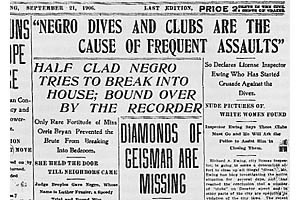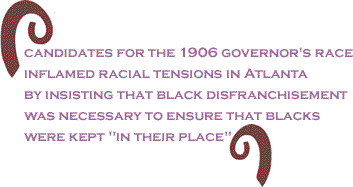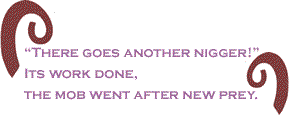|
|
| |
|
| |
|
| |
|
| |
|
| |
|
| |
The
riots that broke out in Atlanta, Georgia between 1898
and 1906 were part of a pattern of anti-black violence
that included several hundred lynchings each year.
The
so-called "Atlanta Race Riot" took place September
22-24, 1906.
During
the summer of 1906, white fears of African Americans�
increasing economic and social power, sensationalized
rhetoric from white politicians, and unsubstantiated
news stories about a black crime wave created a powder
keg of racial tension in Atlanta. The powder keg exploded
on the night of September 22nd in what became known
as the Atlanta Race Riot.
Over
five days at least ten black people were killed while
Atlanta�s police did nothing to protect black citizens,
going so far as to confiscate guns from black Atlantans
while allowing whites to remain armed. White mobs killed
dozens of blacks, wounded scores of others, and inflicted
considerable property damage.
On
the afternoon of Saturday, September 22, Atlanta newspapers
reported four alleged assaults upon local white women,
none of which were ever substantiated.
These
newspaper reports were the catalyst for the riot.


The
New
Georgia Encyclopedia summarizes additional causes
of the riots as follows:
By
the 1880s Atlanta had become the hub of the regional
economy, and the city's overall population soared
from 89,000 in 1900 to 150,000 in 1910; the black
population was approximately 9,000 in 1880 and 35,000
by 1900. Such growth put pressure on municipal services,
increased job competition among black and white workers,
heightened class distinctions, and led the city's
white leadership to respond with restrictions intended
to control the daily behavior of the growing working
class, with mixed success. Such conditions caused
concern among elite whites, who feared the social
intermingling of the races, and led to an expansion
of Jim Crow segregation, particularly in the separation
of white and black neighborhoods and separate seating
areas for public transportation.
The
emergence during this time of a black elite in Atlanta
also contributed to racial tensions in the city. During
Reconstruction (1867-76), black men were given the
right to vote, and as blacks became more involved
in the political realm, they began to establish businesses,
create social networks, and build communities. As
this black elite acquired wealth, education, and prestige,
its members attempted to distance themselves from
an affiliation with the black working class, and especially
from the unemployed black men who frequented the saloons
on Atlanta's Decatur Street. Many whites, while uncomfortable
with the advances of the black elite, also disapproved
of these saloons, which were said to be decorated
with depictions of nude women. Concern over such establishments
fueled prohibition advocates in the city, and many
whites began to blame black saloon-goers for rising
crime rates in the growing city, and particularly
for threats of black sexual violence against white
women.
Additionally,
the candidates for the 1906 governor's race played to
white fears of a black upper class. They inflamed racial
tensions in Atlanta by insisting that black disfranchisement
was necessary to ensure that blacks were kept "in
their place"; that is, in a position inferior to
that of whites. By disfranchising blacks, whites could
maintain the social order.

Walter
White, the future head of the NAACP grew up in Atlanta
and was 13 years old during the 1906 riots. What follows
are excerpts from
his memoirs of how he and his father defended their
home from white rioters.
The
unseasonably oppressive heat of an Indian summer day
hung like a steaming blanket over Atlanta. My sisters
and I had casually commented upon the unusual quietness.
It seemed to stay Mother�s volubility and reduced
Father, who was more taciturn, to monosyllables. But,
as I remember it, no other sense of impending trouble
impinged upon our consciousness.
I
had read the inflammatory headlines in the Atlanta
News and the more restrained ones in the Atlanta Constitution
which reported alleged rapes and other crimes committed
by Negroes. But these were so standard and familiar
that they made�as I look back on it now�little impression.
The stories were more frequent, however, and consisted
of eight-column streamers instead of the usual two
or four-column ones.
Fuel
was added to the fire by a dramatization of Thomas
Dixon�s novel The Clansman in Atlanta. (This was later
made by David Wark Griffith into The Birth of a Nation,
and did more than anything else to make successful
the revival of the Ku Klux Klan.) The late Ray Stannard
Baker, telling the story of the Atlanta riot in Along
the Color Line, characterized Dixon�s fiction and
its effect on Atlanta and the South as �incendiary
and cruel.� No more apt or accurate description could
have been chosen.
During
the afternoon preceding the riot little bands of sullen,
evil-looking men talked excitedly on street corners
all over downtown Atlanta. Around seven o�clock my
father and I were driving toward a mail box at the
corner of Peachtree and Houston Streets when there
came from near-by Pryor Street a roar the like of
which I had never heard before, but which sent a sensation
of mingled fear and excitement coursing through my
body. I asked permission of Father to go and see what
the trouble was. He bluntly ordered me to stay in
the cart. A little later we drove down Atlanta�s main
business thoroughfare, Peachtree Street. Again we
heard the terrifying cries, this time near at hand
and coming toward us. We saw a lame Negro bootblack
from Herndon�s barbershop pathetically trying to outrun
a mob of whites. Less than a hundred yards from us
the chase ended. We saw clubs and fists descending
to the accompaniment of savage shouting and cursing.
Suddenly a voice cried, �There goes another nigger!�
Its work done, the mob went after new prey. The body
with the withered foot lay dead in a pool of blood
on the street.
Father�s
apprehension and mine steadily increased during the
evening, although the fact that our skins were white
kept us from attack. Another circumstance favored
us�the mob had not yet grown violent enough to attack
United States government property. But I could see
Father�s relief when he punched the time clock at
eleven P.M. and got into the cart to go home. He wanted
to go the back way down Forsyth Street, but I begged
him, in my childish excitement and ignorance, to drive
down Marietta to Five Points, the heart of Atlanta�s
business district, where the crowds were densest and
the yells loudest. No sooner had we turned into Marietta
Street, however, than we saw careening toward us an
undertaker�s barouche. Crouched in the rear of the
vehicle were three Negroes clinging to the sides of
the carriage as it lunged and swerved. On the driver�s
seat crouched a white man, the reins held taut in
his left hand. A huge whip was gripped in his right.
Alternately he lashed the horses and, without looking
backward, swung the whip in savage swoops in the faces
of members of the mob as they lunged at the carriage
determined to seize the three Negroes.
There
was no time for us to get out of its path, so sudden
and swift was the appearance of the vehicle. The hubcap
of the right rear wheel of the barouche hit the right
side of our much lighter wagon. Father and I instinctively
threw our weight and kept the cart from turning completely
over. Our mare was a Texas mustang which, frightened
by the sudden blow, lunged in the air as Father clung
to the reins. Good fortune was with us. The cart settled
back on its four wheels as Father said in a voice
which brooked no dissent, �We are going home the back
way and not down Marietta.�

But
again on Pryor Street we heard the cry of the mob.
Close to us and in our direction ran a stout and elderly
woman who cooked at a downtown white hotel. Fifty
yards behind, a mob which filled the street from curb
to curb was closing in. Father handed the reins to
me and, though he was of slight stature, reached down
and lifted the woman into the cart. I did not need
to be told to lash the mare to the fastest speed she
could muster.
The
church bells tolled the next morning for Sunday service.
But no one in Atlanta believed for a moment that the
hatred and lust for blood had been appeased. Like skulls
on a cannibal�s hut the hats and caps of victims of
the mob of the night before had been hung on the iron
hooks of telegraph poles. None could tell whether each
hat represented a dead Negro. But we knew that some
of those who had worn the hats would never again wear
any.
Late
in the afternoon friends of my father�s came to warn
of more trouble that night. They told us that plans
had been perfected for a mob to form on Peachtree
Street just after nightfall to march down Houston
Street to what the white people called �Darktown,�
three blocks or so below our house, to �clean out
the niggers.� There had never been a firearm in our
house before that day. Father was reluctant even in
those circumstances to violate the law, but he at
last gave in at Mother�s insistence.
We
turned out the lights early, as did all our neighbors.
No one removed his clothes or thought of sleep. Apprehension
was tangible. We could almost touch its cold and clammy
surface. Toward midnight the unnatural quiet was broken
by a roar that grew steadily in volume. Even today
I grow tense in remembering it.

Father
told Mother to take my sisters, the youngest of them
only six, to the rear of the house, which offered
more protection from stones and bullets. My brother
George was away, so Father and I, the only males in
the house, took our places at the front windows of
the parlor. The windows opened on a porch along the
front side of the house, which in turn gave onto a
narrow lawn that sloped down to the street and a picket
fence. There was a crash as Negroes smashed the street
lamp at the corner of Houston and Piedmont Avenue
down the street. In a very few minutes the vanguard
of the mob, some of them bearing torches, appeared.
A voice which we recognized as that of the son of
the grocer with whom we had traded for many years
yelled, �That�s where that nigger mail carrier lives!
Let�s burn it down! It�s too nice for a nigger to
live in!� In the eerie light Father turned his drawn
face toward me. In a voice as quiet as though he were
asking me to pass him the sugar at the breakfast table,
he said, �Son, don�t shoot until the first man puts
his foot on the lawn and then�don�t you miss!�
The
mob moved toward the lawn. I tried to aim my gun,
wondering what it would feel like to kill a man. Suddenly
there was a volley of shots. The mob hesitated, stopped.
Some friends of my father�s had barricaded themselves
in a two-story brick building just below our house.
It was they who had fired. Some of the mobsmen, still
bloodthirsty, shouted, �Let�s go get the nigger.�
Others, afraid now for their safety, held back. Our
friends, noting the hesitation, fired another volley.
The mob broke and retreated up Houston Street.
In
the quiet that followed I put my gun aside and tried
to relax. But a tension different from anything I
had ever known possessed me. I was gripped by the
knowledge of my identity, and in the depths of my
soul I was vaguely aware that I was glad of it. I
was sick with loathing for the hatred which had flared
before me that night and come so close to making me
a killer; but I was glad I was not one of those who
hated; I was glad I was not one of those made sick
and murderous by pride.
The
Coalition to Remember the 1906 Atlanta Race Riot believes
that:
over
the years, the collective public memory of this act
of terrorism has faded, but fears that arose from
that violence have continued and have fed the racial
attitudes that segregate our city. Coalition sponsored
activities meant to restore the memory and move toward
reconciliation include: an exhibit at the MLK Historic
Site gallery, curriculum material about the riot in
area schools, artistic expressions and a community-centered
symposium sponsored by local colleges and universities.

Suggested
Reading
Mark
Bauerlein, Negrophobia:
A Race Riot in Atlanta, 1906 (San Francisco: Encounter Books, 2001).
(San Francisco: Encounter Books, 2001).
Charles
Crowe, "Racial Massacre in Atlanta, September 22,
1906," Journal of Negro History 54 (April
1969).
Allison
Dorsey, To
Build Our Lives Together: Community Formation in Black
Atlanta, 1875-1906 (Athens: University of Georgia Press, 2004).
(Athens: University of Georgia Press, 2004).
David
F. Godshalk, Veiled
Visions: The 1906 Atlanta Race Riot and the Reshaping
of American Race Relations (Chapel Hill: University of North Carolina Press,
2005).
(Chapel Hill: University of North Carolina Press,
2005).
Gregory
Mixon, The
Atlanta Riot: Race, Class, and Violence in a New South
City (Southern Dissent) (Gainesville: University Press of Florida,
2005).
(Gainesville: University Press of Florida,
2005).
|
| |
|
| |
|
| |
|
| |
|
| |
|
If you send
us an emaill message we may publish all or part
of it, unless you tell us it is not for publication.
You may also request that we withhold your name.
Thank you
very much for your readership.
|
| |
|
| |
|
| |
|
| Feb 23, 2012 - Issue 460 |
 is
published every Thursday
is
published every Thursday |
| Est. April 5, 2002 |
Executive Editor:
David A. Love, JD |
Managing Editor:
Nancy Littlefield, MBA |
Publisher:
Peter Gamble |
| |
|
|
| |
|
|
| |
| |
| |
| |
| |
| |
| |
| |
| |
|
|

